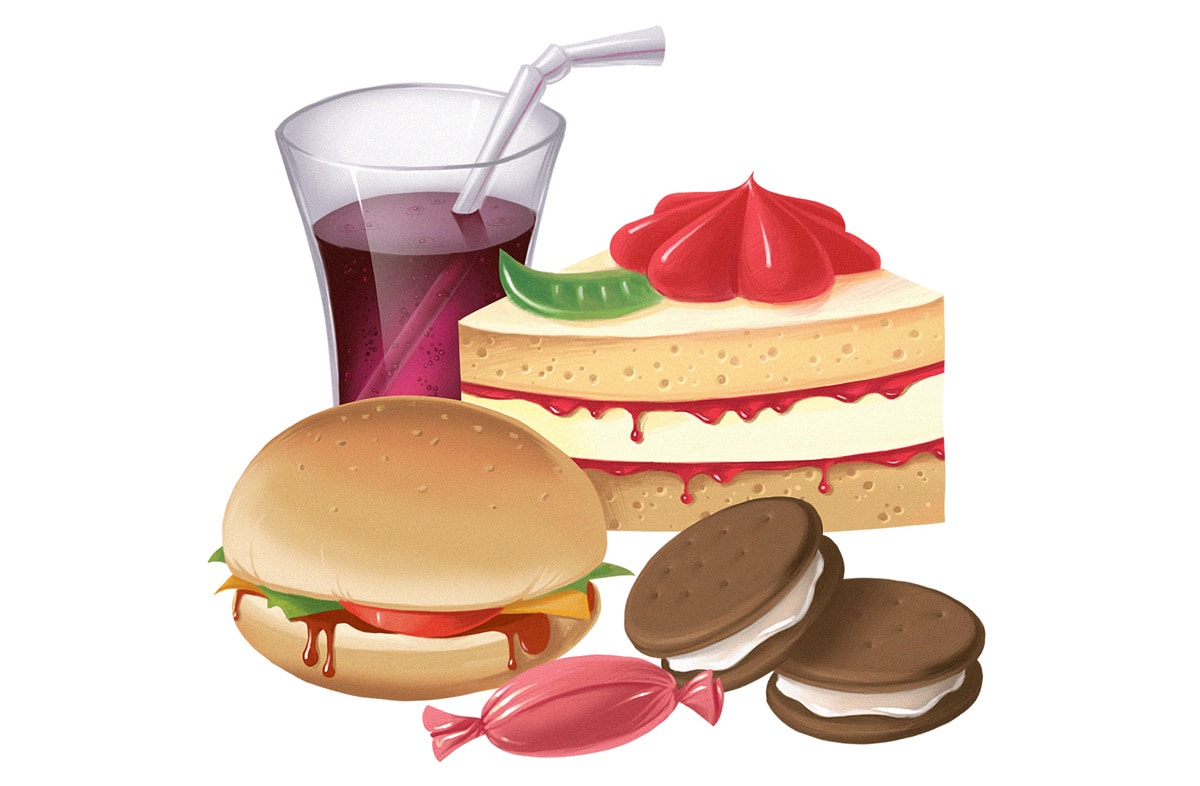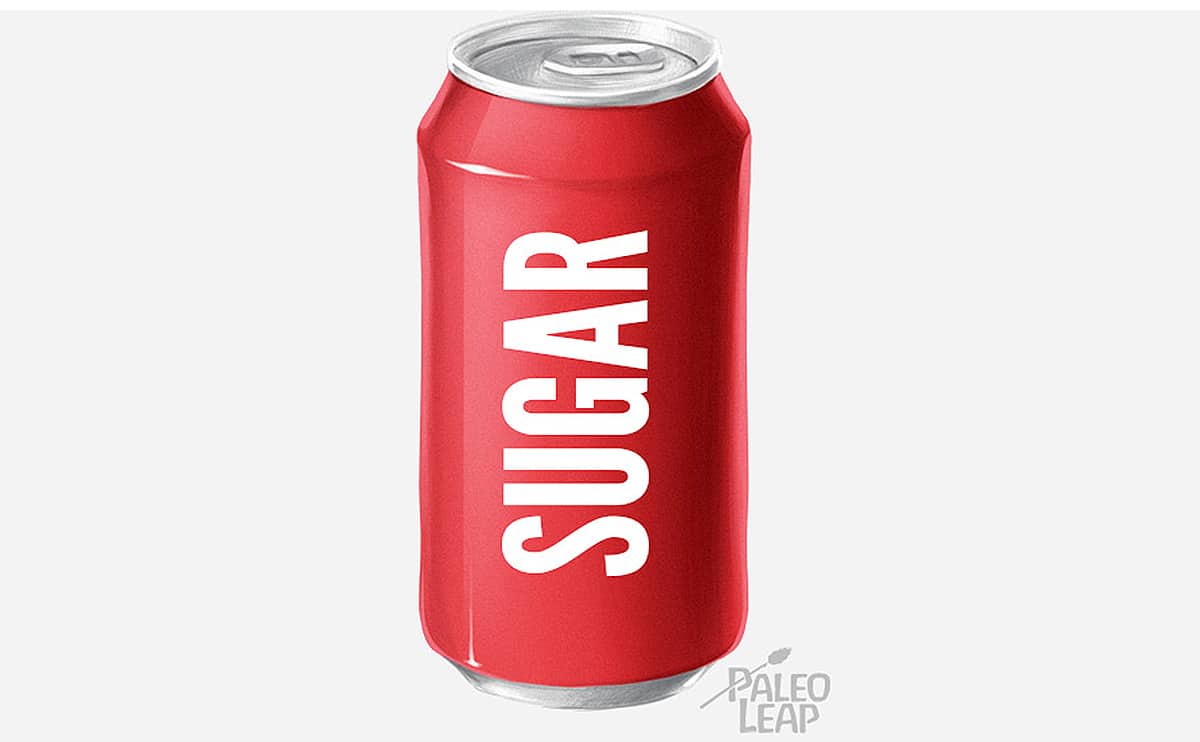It’s “normal” in the United States (and most other industrialized countries) to consume an enormous amount of nutrient-free sugar.
In the US, the average person eats about 13% of their daily calories from added sugar (that’s not counting natural sugar found in fruit or milk, only the added sugar in stuff like candy). In teenagers, it’s even worse: kids 9-13 get about 15% of calories from added sugar, and in the 14-30 age group, it’s closer to 17%.
Around half of that added sugar consumption comes from sugary soft drinks; the rest is all the usual culprits (candy, cookies, “healthy” yogurt with as much sugar as a candy bar…).

The 2015 Dietary Guidelines recommended that people eat no more than 10% of calories from added sugars. That’s already high compared to the American Heart Association recommendation guidelines, but about 70% of Americans exceed even the ultra-generous Dietary Guidelines limit.
It’s not a few chronic Mountain Dew addicts who are driving up the average numbers here. If you like fractions better than percents, think about it this way: in a statistically average American diet, about 1/16 of calories come from pure sugar with absolutely 0 nutritional value (sugary soda), and another 1/16 come from sugary junk food, for a total of around ⅛ of calories coming from foods that basically do nothing good for your body. This is what a “normal” eating pattern looks like in the US, and numbers from plenty of other countries are similar.
Ready for some more depressing statistics? It’s also “normal” to have a laundry list of chronic health problems:
- 33.5% of people in the US have high blood pressure
- 9.4% have diabetes
- over 30% are obese.
These facts aren’t unrelated to the typical American sugar consumption. In fact, they’re very much connected. Here’s a look at how a sugar consumption within a “normal” dietary range puts people at risk for these diseases - if this is what “normal” gets us, maybe it’s not so bad to be “extreme.”
Risks of a “Normal” Sugar Intake: Weight Problems
There’s no one single demon nutrient that causes obesity all by itself: not fat, not sugar, not cholesterol, not carbs. But sugar is one of the clear contributing factors.
This review looked at randomized controlled trials where participants were instructed to eat different amounts of sugar. The researchers concluded that:
- Reducing dietary sugar reduces body weight.
- Increasing dietary sugar increases body weight
- This is mostly because in free-living people, sugar adds excess calories to the diet: strict replacement of sugar with other types of calories doesn’t affect weight, but in real life, that’s just not how people eat sugar.
These weren’t “extreme” diets. In fact, a lot of them looked pretty “normal.” For example, a lot of the high-sugar or increased-sugar studies just had the subjects add sugary soda to their usual diet - and their weight shot up. On the flip side, a lot of the low-sugar or reduced-sugar studies just had people switch to sugar-free foods or drink water - and their weight started dropping compared to controls who kept eating their usual diet.
These also weren’t mouse or rat studies, and they weren’t just population studies where the researchers found an association between eating sugar and obesity. These were intervention studies, where adding sugar to subjects’ diets in “normal” dietary amounts clearly contributed to weight gain.
Risks of a “Normal” Sugar Intake: Hypertension and Hyperlipidemia
“Blood lipids” means cholesterol and triglycerides. It's debatable how much blood cholesterol really tells you about your health, and it's definitely more complicated than just "total cholesterol," but it's still a useful marker to keep track of. And hypertension (high blood pressure) is definitely bad news.
Dietary cholesterol doesn't actually raise blood cholesterol much in most people, but sugar is a different story. Take a look at this review. The researchers looked at randomized controlled trials in humans where people ate different amounts of sugar. They concluded that…
- High-sugar diets tend to raise blood pressure, triglycerides, total cholesterol, and LDL cholesterol specifically.
- Low-sugar diets lower all of the above.
This effect was completely independent of weight. It wasn’t that the sugar caused weight gain, which in turn caused high cholesterol. In fact, the cholesterol-raising effect of sugar was strongest in studies where the subjects didn’t gain weight.
Again, most of the “high” sugar diets seemed quite normal. Sugar came from sources like “papaya sorbet” (sounds tasty), “typical Western diet,” 600 mL of soda (about 2 normal-sized cans), or “a sugar-sweetened cocoa beverage” (aka hot chocolate). In other studies, the researchers used special sucrose supplements, but in similar amounts. These aren’t super-extreme diets where the researchers took rats and injected pure sugar directly into their livers or anything like that - these are typical American/western diets...causing significant increases in cardiovascular risk factors because of the amount of sugar they contain.
Risks of a “Normal” Sugar Intake: Type 2 Diabetes
When it comes to sugar and type 2 diabetes, intervention studies are understandably thin on the ground. Diabetes is a slow-developing disease that gets steadily worse over years and decades, and it’s difficult and expensive to follow people around enforcing a study diet for that long. Many studies have found associations between diabetes and sugar consumption, but there's also some evidence in a slightly higher tier: prospective cohort studies.
In a prospective cohort study, researchers take people who don’t have a disease (in this case, diabetes), and track them for several years to see which ones develop the disease. Several prospective cohort studies have looked at the relationship between sugar consumption and diabetes.

In this study, the subjects were over 90,000 women. At the beginning of the study, none of them had diabetes. But women who drank one or more sugary sodas per day had nearly twice the risk of developing diabetes in four years, compared to women who drank less than one soda per day. One can of Coke has 156 calories from added sugar. The average American gets about 135 calories of sugar per day from soft drinks. So one can of Coke per day is more or less in line with the average daily sugar consumption, but it’s enough to substantially increase diabetes risk.
A review of prospective cohort studies published between 2000 and 2011 found significant support for the hypothesis that a typical western diet with high sugar consumption increases the risk of developing Type 2 diabetes.
On the other hand, in this study, the researchers took overweight teenagers at risk of diabetes. They instructed the subjects to eat less sugar and more fiber. Taking out the equivalent of 1 can of Coke from the teens’ typical diet significantly improved their metabolic health, insulin sensitivity, and glucose tolerance.
Other Diseases
Diabetes, high cholesterol, high blood pressure, and obesity affect an enormous number of people, so they’re good example cases. But the list doesn’t stop there. Just to take two examples, studies have suggested that dietary sugar is a causal factor in cavities (dental caries) and non-alcoholic fatty liver disease (Studies: one, two).
“Normal” and “Extreme” are Relative
If the typical American sugar consumption is “normal,” then a Paleo style diet is “extreme.” But what kind of “normal” is that? Do we really want it to be “normal” for so many people to be so badly sick? Is it really useful to define concepts like “moderation” in reference to such a messed-up “normal”? If that’s “normal,” then maybe we need to get a little extreme.
The Bigger Picture
Of course, if you take the bigger picture, the typical American diet isn’t “normal” at all. Look over our whole evolutionary history, and the American sugar consumption sticks out like a sore thumb. In the big picture, it’s very abnormal - and we’re seeing all the consequences of eating a diet that doesn’t fit with our evolutionary heritage.
In that sense, Paleo isn’t “extreme” at all. If you look at the whole evolutionary history of homo sapiens, Paleo is just a return to “normal.” In the history of the species, the past 30 or 40 years have basically been that one party weekend when everything goes completely off the rails. But now it’s Monday morning and it’s time to get back to the routine.
As long as a typical American sugar intake is “normal,” then all these diseases - diabetes, heart disease, fatty liver disease - will also be “normal.” But none of these things have to be “normal” at all, or at least, you don't have to just accept them as your normal.





Leave a Reply